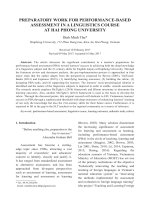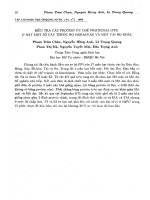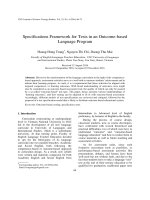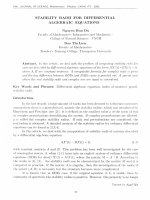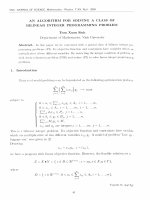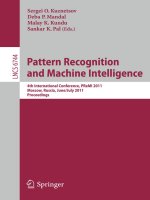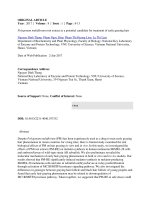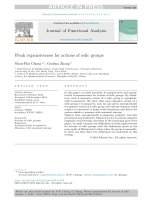DSpace at VNU: Data mining for materials design: A computational study of single molecule magnet
Bạn đang xem bản rút gọn của tài liệu. Xem và tải ngay bản đầy đủ của tài liệu tại đây (1.12 MB, 10 trang )
Data mining for materials design: A computational study of single molecule magnet
Hieu Chi Dam, Tien Lam Pham, Tu Bao Ho, Anh Tuan Nguyen, and Viet Cuong Nguyen
Citation: The Journal of Chemical Physics 140, 044101 (2014); doi: 10.1063/1.4862156
View online: />View Table of Contents: />Published by the AIP Publishing
Articles you may be interested in
Wavelet methods in data mining
AIP Conf. Proc. 1463, 103 (2012); 10.1063/1.4740042
Tailoring magnetic properties in Mn4 molecules: A way to develop single-molecule magnets
J. Appl. Phys. 109, 07B105 (2011); 10.1063/1.3545812
The LSST Data Mining Research Agenda
AIP Conf. Proc. 1082, 347 (2008); 10.1063/1.3059074
DataSpace: A Data Web for the Exploratory Analysis and Mining of Data
Comput. Sci. Eng. 4, 44 (2002); 10.1109/MCISE.2002.1014979
Sampling Strategies for Mining in Data-Scarce Domains
Comput. Sci. Eng. 4, 31 (2002); 10.1109/MCISE.2002.1014978
This article is copyrighted as indicated in the article. Reuse of AIP content is subject to the terms at: Downloaded to IP:
130.88.90.140 On: Sun, 04 Jan 2015 16:54:20
THE JOURNAL OF CHEMICAL PHYSICS 140, 044101 (2014)
Data mining for materials design: A computational study
of single molecule magnet
Hieu Chi Dam,1,2 Tien Lam Pham,1 Tu Bao Ho,1 Anh Tuan Nguyen,2
and Viet Cuong Nguyen3
1
Japan Advanced Institute of Science and Technology, 1-1 Asahidai, Nomi, Ishikawa 923-1292, Japan
Faculty of Physics, Vietnam National University, 334 Nguyen Trai, Hanoi, Vietnam
3
HPC Systems, Inc., 3-9-15 Kaigan, Minato-ku, Tokyo 108-0022, Japan
2
(Received 18 July 2013; accepted 1 January 2014; published online 23 January 2014)
We develop a method that combines data mining and first principles calculation to guide the designing of distorted cubane Mn4 + Mn3+
3 single molecule magnets. The essential idea of the method is a
process consisting of sparse regressions and cross-validation for analyzing calculated data of the materials. The method allows us to demonstrate that the exchange coupling between Mn4 + and Mn3 +
ions can be predicted from the electronegativities of constituent ligands and the structural features of
the molecule by a linear regression model with high accuracy. The relations between the structural
features and magnetic properties of the materials are quantitatively and consistently evaluated and
presented by a graph. We also discuss the properties of the materials and guide the material design
basing on the obtained results. © 2014 AIP Publishing LLC. [ />I. INTRODUCTION
Quantum calculation plays a very important role in the
process of materials design nowadays. For a material with
a given hypothesized structural model, the electronic structure, as well as many other physical properties can be predicted by solving the Schrödinger equation. Conventionally,
the ground state’s potential energy of a material is calculated
using atomic positions in the hypothesized structure model.
By optimizing the ground state’s potential energy, the optimal
structure can be derived. The features of an optimal structure
model of materials, as well as its derived physical properties,
results in a series of optimizing processes, and in addition
has strong multivariate correlations. The task of materials design is to make these correlations clear and to determine a
strategy to modify the materials to obtain desired properties.
However, such correlations are usually hidden and difficult to
uncover or predict by experiments or experience. As a consequence, the design process is currently performed through
time-consuming and repetitive experimentation and characterization loops, and to shorten the design process is clearly
a big target in materials science. In an effort to improve on
existing techniques, we propose a first principle calculationbased data mining method and demonstrate its potential for
a set of computationally designed single molecular magnets
with distorted cubane Mn4 + Mn3+
3 core (Mn4 SMMs).
Data mining is a broad discipline that aims to develop
and use methods for extracting meaningful information and
knowledge from large data sets. To the field of computational
materials science, data mining methods have recently been
used with successes, for example, in solving Fokker-Planck
stochastic differential equations,1 in predicting crystal structure and discovering new materials,2, 3 in parametrizing interatomic force fields for fixed chemical composition,4, 5 and in
predicting molecular atomization energies6, 7 by merging data
mining with quantum calculations. Motivated by using data
0021-9606/2014/140(4)/044101/9/$30.00
mining to solve data-intensive problems in materials science,
we develop a method to quantitatively model a family of materials by graph, using their quantum calculated data. The key
idea of our method is to use advanced statistical mining algorithms, in particular multiple linear regression with LASSO
regularized least-squares8, 9 to solve the sparse approximation
problem on the space of structural and physical properties of
materials. We use cross-validation10 to consistently and quantitatively evaluate the conditional relations of each feature on
to all the other features in terms of prediction. Based on the
obtained relations, a graph representing relations between all
properties of materials can be constructed. Furthermore, we
propose a graph optimization method to have better visual
representation and easier inferences on the controlling features of the materials. The obtained graph is not only significant for the comprehension of the physics relating to the materials, but also valuable for the guidance of effective material
design.
The main contribution of this work includes: (1) a quantitative and rational solution to the modeling of the structural
and physical properties of the distorted cubane Mn4 + Mn3+
3
SMMs; (2) a first principles calculation-based data mining approach that can be applied to accelerate the understanding and
designing of materials.
II. MATERIAL SYSTEM
In this paper, we focus on SMMs which are recently being extensively studied due to their potential technological applications in molecular spintronics.11–16 SMMs can function
as magnets and display slow magnetic relaxation below their
blocking temperature (TB ). The magnetic behavior of SMMs
results from a high ground-state spin combined with a large
and negative Ising type of magnetoanisotropy, as measured by
the axial zero-field splitting parameter.17–19
140, 044101-1
© 2014 AIP Publishing LLC
This article is copyrighted as indicated in the article. Reuse of AIP content is subject to the terms at: Downloaded to IP:
130.88.90.140 On: Sun, 04 Jan 2015 16:54:20
Dam et al.
044101-2
J. Chem. Phys. 140, 044101 (2014)
A site: Mn 4+
B site: Mn 3+
L1 site: O, N
X site: F, Cl, Br
Z1 site: O, N
Z1
A
OZ
µ3-L1
OXY
B
OXY
L2
µ3-X
2−
FIG. 1. Schematic geometric structure of [Mn4 + Mn3+
3 (μ3 -L)3 (μ3
−
−
−
-X) Z3 (CH(CHO)2 )3 ] molecules, with L = L1L2, Z = (CH3 COZ1)3 Z2,
Z13 -Z2 = O3 or N3 –(CCH2 )3 CCH3 . Color code: Mn4 + (violet), Mn3 + (purple), L1 (blue), X (light green), Z1 (light blue), C (grey). H atoms and Z2
group are removed for clarity.
SMM consists of magnetic atoms connected and surrounded by ligands, and the challenge of researching SMM
consists in tailoring magnetic properties by specific modifications of the molecular units. The current record of the TB of
SMMs is only several degrees Kelvin, which can be attributed
to weak intra-molecular exchange couplings between magnetics metal ions.16 The design and synthesis of SMMs with
higher TB that are large enough for practical use, are big challenges for chemists and physicists. In the framework of computational materials design, the SMM with distorted cubane
Mn4 + Mn3+
3 core is one of the most attractive SMM systems
because their interesting geometric structure and important
magnetic quantities can be well estimated by first-principles
calculations.14, 15
In this paper, we construct and calculate a database of
structural and physical properties of 114 distorted cubane
Mn4 + Mn3+
3 SMMs with full structural optimization by firstprinciples calculations (Fig. 1). A data mining method is applied to the calculated data to explore the relation between
structural and physical properties of the SMMs. We quantitatively model the structural and physical properties of the
SMM by a graph that allows us to infer and to guide the
molecular design process (Fig. 2).
III. METHODOLOGY
A. Data generation
1. Molecular structure construction
New distorted cubane Mn4 + Mn3+
SMMs have been
3
designed by rational variations in the μ3 -O, μ3 -Cl, and
O2 CMe of the synthesized distorted cubane Mn4 + Mn3+
3 (μ3 −
(dbm)
(hereafter
Mn
O2 − )3 (μ3 -Cl− )(O2 CMe)−
4 -dbm)
3
3
molecules.20–24
In Mn4 -dbm molecules, the μ3 -O atoms form Mn4 + (μ3 -O2 − )-Mn3 + exchange pathways between the Mn4 + and
Mn3 + ions. Therefore, substituting μ3 -O with other ligands
1. Construct molecular structural models of SMMs and
carry out first principles calculation to optimize the
molecular structures.
2. Calculate structural, chemical, and physical property
features using the optimized molecular structures. Use
these features to represent all the constructed molecules
in a feature space.
3. Take each feature as a response feature and predict it
by a regression analysis using the other features.
4. Evaluate quantitatively the impact of each feature on
the prediction accuracy of the regression analysis of the
other features.
5. Build a directed graph with features as nodes and their
impacts on other features as edges to represent the
whole picture of the relation between features.
6. Simplify the obtained graph by removing unnecessary
features for specific materials design purposes.
FIG. 2. Framework of first principle calculation based-data mining to model
the physical properties of SMMs.
will be an effective way to tailor the geometric structure of exchange pathways between the Mn4 + and Mn3 + ions, as well
as the exchange coupling between them.
To preserve the distorted cubane geometry of the core of
Mn4 + Mn3+
3 molecules and the formal charges of Mn ions,
ligands substituted for the core μ3 -O ligand should satisfy
the following conditions: (i) To have the valence of 2; (ii)
the ionic radius of these ligands must be not so different
from that of O2 − ion. From these remarks, nitrogen-based
ligands, NR (R = a radical), must be the best candidates.
Moreover, through variation in the R group, the local electronic structure as well as electronegativity at the N site can
be controlled. As a consequence, the Mn–N bond lengths
and the Mn4 + –N–Mn3 + angles (α), as well as delocalization
of dz2 electrons from the Mn3 + sites to the Mn4 + site and
the exchange coupling between them (JAB ) are expected
to be tailored. In addition, through variations in the core
μ3 -Cl ligand and the O2 CMe ligands, the local electronic
structures at Mn sites are also changed. Therefore, combining
variations in μ3 -O, μ3 -Cl, and O2 CMe ligands is expected to
be an effective way to seek new superior Mn4 + Mn3+
3 SMMs
with strong JAB , as well as to reveal magneto-structural
correlations of Mn4 + Mn3+
3 SMMs. By combining variations
in μ3 -O, μ3 -Cl, and O2 CMe ligands, 114 new Mn4 + Mn3+
3
molecules have been designed. For a better computational
cost, the dbm groups are substituted with CH(CHO)2 groups,
which shows no structural and magnetic properties change
after the substitution.25, 26 The designed molecules have
2−
)3 (μ3 a general chemical formula [Mn4 + Mn3+
3 (μ3 -L
−
− −
X )Z3 2 )(CH(CHO)3 ] (hereafter Mn4 L3 XZ) with L
= O, NH, NCH3 , NCH2 –CH3 , NCH=CH2 , NC≡CH,
NC6 H5 , NSiH3 , NSiH=CH2 , NGeH2 –GeH3 , NCH=SiH2 ,
NSiH=SiH2 , NSiH2 –CH3 , NCH2 –SiH3 , NGeH2 –CH3 ,
NCH2 –GeH3 , NSiH2 –GeCH3 , NGeH2 –SiH3 , or NSiH2 –
SiH3 ; X = F, Cl, or Br; and Z3 = (O2 –CMe)3 or MeC(CH2 –
NOCMe)3 . Details of the constructed SMMs can be found
elsewhere.12–15, 25, 26
This article is copyrighted as indicated in the article. Reuse of AIP content is subject to the terms at: Downloaded to IP:
130.88.90.140 On: Sun, 04 Jan 2015 16:54:20
044101-3
Dam et al.
2. Molecular structure optimization
The constructed molecular structures were optimized
by using the same computational method as in our previous paper.25, 26 All calculations have been performed at the
density-functional theory (DFT) level27 by using DMol3 code
with the double numerical basis sets plus polarization functional (DNP).28, 29 For the exchange correlation terms, the
revised generalized gradient approximation (GGA) RPBE
functional was used.30 All electron relativistic was used
to describe the interaction between the core and valence
electrons.31 The real space global cutoff radius was set to be
4.7 Å for all atoms. The spin unrestricted DFT was used to
obtain all results presented in this study. Since the experimental results reported so far indicate the collinearity of the
magnetic properties of the materials, all the DFT calculations
are carried out within a collinear magnetic framework.22, 32, 33
The atomic charge and magnetic moment were obtained by
using the Mulliken population analysis.34 For better accuracy, the octupole expansion scheme is adopted for resolving the charge density and Coulombic potential, and a fine
grid is chosen for numerical integration. The charge density
is converged to 1×10−6 a.u. in the self-consistent calculation.
In the optimization process, the energy, energy gradient, and
atomic displacement are converged to 1×10−5 , 1×10−4 , and
1×10−3 a.u., respectively. In order to determine the groundstate atomic structure of each Mn4 + Mn3+
3 SMM, we carried
out total energy calculations with full geometry optimization,
allowing the relaxation of all atoms in molecules.
3. Data representation
One of the most important ingredients for data mining is
the choice of an appropriate data representation that reflects
prior knowledge of the application domain, i.e., a model of
the underlying physics. For representing structural and physical properties of each distorted cubane Mn4 + Mn3+
3 SMMs,
we use a combination of 17 features. We divide all the features into four groups. The first group pertains to the features
for describing the electronic properties of the constituent ligands, including (1) electron negativity of X (χ X ), (2) electron
negativity of L1 (χ L1 ), (3) electron negativity of Z1 (χ Z1 ),35, 36
(4) electron affinity of L (ELEA ).37 The selection of these features comes from the physical consideration that the local
electronic structures, as well as electron negativities at ligand sites, will determine the d orbital splitting at Mn ion sites.
Furthermore, since we intentionally vary ligand groups, these
electronic features are just considered as explanatory features
in the following analysis process.
To have a good approximation of the physical properties of SMMs, it is natural to introduce intermediate features.
From the domain knowledge, we know that information on
molecular structure, such as bond length, bond angle, and
structure of octahedral sites, is very valuable in relation to understanding the physics of molecular materials with transition
metal. Therefore, we design the second group with structural
features which represent the core structure and the structures
of the octahedral fields at A and B sites. The features for the
core structures are: (5) the distance between the A site and B
J. Chem. Phys. 140, 044101 (2014)
site (dAB ), (6) the distance between B sites (dBB ), (7) the distance between the A site and L1 site (dAL1 ), (8) the distance
between the B site and L1 site (dBL1 ), (9) the angle AL1B
(α), and (10) the angle BL1B (β). The features for the structures of octahedral fields at A and B sites are (11) the distance
between the A site and Z1 (dAZ1 ), (12) the distance between
the B site and Oxy (dBOxy ), and (13) the distance between the
B site and Oz (dBOz ). These features are calculated from the
optimized molecular structure and considered as structural intermediate features.
The third group of features includes (14) the magnetic
moment of Mn4 + ion at site A (mA ) and (15) the magnetic
moment of Mn3 + ions at site B (mB ). These two features
are magnetic intermediate features. The last group includes
targeting magnetic properties, which are (16) exchange coupling between Mn4 + and Mn3 + ions at sites A and B (JAB /kB ),
and (17) exchange coupling between Mn3 + ions at sites B
(JBB /kB ). The magnetic moments of the Mn ions are calculated by the Mulliken method. The exchange coupling parameters of the molecules are calculated by using the total energy
difference method. Details of the calculation method are described elsewhere.25, 26, 38 It should be noted that the features
in the first group are the only features that can be obtained at
a very low cost, without first principles calculations.
B. Data analysis
1. Parallel regression
We perform a parallel regression process on the calculated data. With each feature, we perform a regression in
which the feature we are focusing on is considered as a response variable, and the other features are considered as explanatory variables. The response variable is expressed as a
linear combination of selected explanatory variables (from
all availables) that have the lowest prediction risk. The main
purpose of this regression is to extract a set of features that
are sensitive in predicting the value of the feature we are
focusing on. Commonly, regression methods use the leastsquares approach. However, for the sparse data with ill condition, it is often the case that a bias-variance tradeoff must be
considered to minimize the prediction risk. For this purpose, in the regression process, the LASSO regularized leastsquares has been applied.8, 9
In a standard regression analysis, we solve a least-squares
problem, that minimizes
1
m
m
predict
yi
2
− yiobs ,
i=1
predict
where m is the total number of samples in the data set; yi
and yiobs are the predicted and the measured values, respecpredict
tively. The predicted values yi
are calculated from the
linear regression function
n
predict
yi
j
=
β j xi + β 0 ,
j =1
where n is the total number of variables considered in the
j
regression model, xi represents the value of the explanatory
This article is copyrighted as indicated in the article. Reuse of AIP content is subject to the terms at: Downloaded to IP:
130.88.90.140 On: Sun, 04 Jan 2015 16:54:20
044101-4
Dam et al.
J. Chem. Phys. 140, 044101 (2014)
variable j for the sample i, and β j are the sought coefficients
corresponding to explanatory variable j, which determines
how the explanatory variables are (optimally) combined to
yield the result ypredict . In LASSO regularized least-squares
regression,8 we minimize the penalized training error with 1 norm of regression coefficients
1
m
n
predict
yi
−
2
yiobs
+λ
|β j |.
j =1
i
To estimate the prediction risk, we do not use the trainpredict
− yiobs )2 , since it is biased. Ining error m1 i∈training (yi
stead, we use leave-one-out cross-validation. In this validation, one sample (ith sample) is removed and the remaining m
− 1 samples are used for training the regression model. The
removed sample (ith sample) is used to test and calculate the
predict
obs
2
test error (yi−lef t − yi−lef
t ) . The process is repeated m times
for every sample, so that every sample has a chance to be the
removed once. Finally, we take the average of the test errors
1
ˆ
R(λ)
=
m
2
predict
obs
yi−lef t − yi−lef
t ,
i
where the sum is taken over all the mfolds in the crossvalidation. We use it as a measure for the prediction risk, and
the value of λ will be tuned to minimize this prediction risk.
The explanatory variables of which the corresponding coefficients β j are non-zero, are considered as sensitive explanatory
variables to the response variable in the regression. By using
the LASSO, we can assess the relation between the features
we used for the data representation.
To evaluate quantitatively the relation between a specific
sensitive explanatory variable xj and the response variable, we
carry out again the procedure of regression and prediction risk
estimation by a leave-one-out cross-validation, using all but
one (xj ) sensitive explanatory variables. The prediction risk
Rˆ j obtained from this procedure reflects quantitatively how
the prediction of the response variable is impaired by removing the concerning variable xj . In the case of weak correlation
between explanatory variable xj and the response variable, the
prediction risk must not change much and Rˆ j Rˆ opt . On the
other hand, if the explanatory variable xj has a strong relation
with the response variable, the removal of xj from the set of
sensitive explanatory variables for the regression will impair
the model for prediction, and therefore, dramatically increase
Rˆ opt . Another consideration is
the prediction risk and Rˆ j
39
that if the score stotal of a regression for all samples using all
the sensitive explanatory variables is low, the linear relation
between every explanatory variable and the response variable
must be poor. Therefore, we normalize the prediction risk Rˆ j
with considering the total score stotal by
Ij = stotal ×
Rˆ j
ˆ
i Ri
,
and use these values to quantitatively evaluate the relative impact of a sensitive explanatory variable to the response variable. The Ij can take a value between 0 and 1, and the sum of
all Ij is stotal . The Ij with a larger value indicates the higher impact of the explanatory variable j to the response variable. The
impacts of the other non-sensitive variables to the response
variable are set to 0. This procedure is repeated for every feature and we can obtain the relations (in terms of sensitivity for
prediction) between every pair of features. It should be noted
that the difference in prediction risk is estimated in the context
that all the other sensitive explanatory variables are used in the
regression model. Therefore, the obtained relative impact of a
sensitive explanatory variable on the response variable should
be different from simple correlations between two variables.
In other words, the relation between each pair of features is
evaluated with the consideration of all the other relations.
2. Modeling relations between features by graph
From the obtained relations, we can build a directed
graph in which nodes are features and edges are the relations
between features, thus representing the whole picture of the
relations between the features. Directions of edges are from
response variables to explanatory variables in the regression.
For the purpose of materials design, we added weights to the
edges with the values of the obtained relative impacts of the
sensitive explanatory variable on the response variable. Further, the edges are assigned with colors (red and blue) to differentiate the respective positive and negative correlations between variables which can be extracted from the corresponding coefficients in the linear regression models.
The relation between features can be asymmetric, therefore there may be two edges with vice versa direction and
different weights (the relative impact Ij ) between two nodes.
It should be noted that Bayesian network is another choice for
modeling the relations between features by a graphical model.
However, automatical learning of a graph structure from data
for a Bayesian network is an extremely heavy task. In contrasts, with this method a structure together with parameters
of the network can be automatically derived from data at the
same time with a parallelism.40
We repeat the following steps to simplify the obtained
graph: (1) remove all independent features that are not sensitive to any other features; (2) remove all intermediate features
that are not sensitive to any other features; (3) remove an intermediate feature that can be predicted perfectly (regression
score 1) by using the other features that are not sensitive
to targeting magnetic properties features; (4) then recreate the
graph using the remaining features. Steps (1) and (2), remove
features that do not make sense in the prediction of the targeting magnetic properties. Step (3) removes unnecessary intermediate features. Features are removed one by one, and step
(4) preserves the consistency of the outcome graph.
IV. RESULTS AND DISCUSSIONS
A. Magnetic property prediction
We first examine whether the exchange coupling JAB /kB
can be directly predicted from electronic properties (features
(1)–(4)) of the constituent ligands. Only a rough linear regression with an average relative error of more than 25% (R
< 0.6) is obtained for the exchange coupling JAB /kB by using
χ X , χ L1 , χ Z1 , and ELEA as explanatory variables. This result
indicates that it is hard to observe a simple linear correlation
This article is copyrighted as indicated in the article. Reuse of AIP content is subject to the terms at: Downloaded to IP:
130.88.90.140 On: Sun, 04 Jan 2015 16:54:20
Dam et al.
044101-5
J. Chem. Phys. 140, 044101 (2014)
using electronic features
250
using structural features
Predicted JAB/kB (K)
using all features
200
150
100
50
0
0
50
100
150
200
250
Calculated JAB/kB (K)
FIG. 3. Calculated (by DFT) and predicted (by data mining) exchange couplings JAB /kB for 114 distorted cubane Mn4 + Mn3+
3 single molecular magnets. The green crosses represent the results of a linear regression using electronic features. The red circles represent the results of a linear regression
using structural features α, dAB , and dBB . The blue solid circles represent the
results of a linear regression using electronic features and structural features
together. The red line represents the ideal correlation between calculated and
predicted results.
between the magnetic properties and the electronic properties
of the constituent ligands for the SMMs. However, it should
be noted that this result does not mean that the exchange coupling JAB /kB of the SMMs has no correlation with the electronic properties of the constituent ligands. It will be a great
interest if these correlations appear when we take the other
features into account.
Next, the relation between the exchange coupling JAB /kB
and the geometrical structures of SMMs are studied. A linear
regression using structural features (features (5)–(13)) is performed. It is found that the exchange coupling JAB /kB can be
predicted quite well by a linear model using α, dAB , and dBB
with an average relative error of 11% (R = 0.9). This result
implies that the geometrical structure of the distorted cubane
Mn4 + Mn3+
3 core is the determinant factor for the magnetic
properties of the SMMs. The prediction accuracy of the regression is dramatically improved when we take together the
electronic properties of ligands into account. With a linear
model using α, dAB , dAZ1 , dBOxy , χ X , and ELEA , the exchange
coupling JAB /kB of SMMs can be predicted accurately with an
average relative error of less than 5% (R = 0.98) (Fig. 3).
From this result, it is obvious that the electronic properties of the constituent ligands strongly correlate with the geometrical structure factors, and all of these features cooperatively contribute to the determination of the exchange coupling JAB /kB . Furthermore, it is interesting that the features
representing the structures of octahedral fields at the A and B
sites (dAZ1 and dBOxy ) become strongly sensitive in the prediction of JAB /kB when the electronic features are considered.
This result implicitly shows the relations between dAZ1 , dBOxy ,
and the electronegativities of constituent ligands which are
well known in the ligand field theory with the effect of d orbital splitting.41
Similar analyses are done for the other magnetic properties. The obtained results show that exchange coupling JBB /kB
cannot be predicted by a linear regression model using the
features. This result can be explained by the facts that the exchange coupling JBB /kB is derived from a complicated formula
of the total energies of three magnetic states of SMMs including the antiferromagnetic state, the ferromagnetic state, and
the mix state (in which the Mn ion at the A site is ferromagnetically coupled to a Mn ion at the B site, and both of them
are antiferromagnetically coupled to the other two Mn ions
at the B site).38 The constituent ligands (especially ligand L)
involved in both the magnetic interaction between Mn ions at
the A and B sites, and the magnetic interaction between Mn
ions at the B sites. Further, the value of the exchange coupling
JBB /kB is one order smaller than that of the exchange coupling
JAB /kB . The design for new features that are more informative to estimate the two magnetic interactions is promising to
improve the predictive power of the method on the exchange
coupling JBB /kB .
The magnetic moment mA of the Mn4 + ion at the A site
can be fairly predicted by a linear regression model using four
features: β, dAB , dAZ1 , and dBOxy with an average relative error
of 1.3% (R = 0.91) (Fig. 4(a)). On the other hand, the magnetic moment mB of Mn3 + ions at sites B can be accurately
predicted by a linear regression model using dAB , dAZ1 , dBL1 ,
dBOxy , and all the four electronic features with an average relative error of 0.33% (R = 0.96) as shown in Figure 4(b).
B. Correlations between features of the SMMs
and a molecular design strategy
Figure 5 shows the graph built from the obtained relations
between all the features. It is clearly seen that the obtained
graph appears with two groups of structural features, in which
features are strongly correlated to each other: the group of features α, dAB , dAL1 , and dBL1 , and the group of features dBB and
β. The values of dAB positively correlate with the values of all
the three features α, dAL1 , and dBL1 . The values of dBB positively correlate with the values of β in the same manner. These
correlations can be qualitatively estimated from the rigid geometrical structure of the distorted cubane Mn4 + Mn3+
3 cores
of the SMMs.
We carry out the above mentioned graph simplification
process. The features dBB , dBL1 , and β are removed since they
can be predicted well by using the other features. The features
mA , mB , and dBOz are also removed since they are not sensitive to targeting magnetic properties features. The relations
between the remaining features are recalculated and summarized in the simplified graph as shown in Figure 6.
Interestingly, it is clearly seen that the distance dBOxy is
sensitive to the exchange coupling JAB /kB , but cannot be predicted by a linear regression model using the electron negativities of the constituent ligands. Further investigation for
seeking the features that are sensitive to dBOxy is promising.
To have a better understanding about the correlations between features, we plot all the constructed SMMs in a 2D
plane using the distance dAB and angle α as axes (Fig. 7). The
This article is copyrighted as indicated in the article. Reuse of AIP content is subject to the terms at: Downloaded to IP:
130.88.90.140 On: Sun, 04 Jan 2015 16:54:20
044101-6
Dam et al.
J. Chem. Phys. 140, 044101 (2014)
FIG. 4. Calculated (by DFT) and predicted (by data mining) magnet moments of Mn4 + ion at site A and Mn3 + ion at sites B ((a) mA and (b) mB ) for 114
distorted cubane Mn4 + Mn3+
3 single molecular magnets. The red line represents the ideal correlation between calculated and predicted results.
FIG. 5. The graph represents all relations between the features. Brown nodes and white nodes indicate independent and dependent features, respectively. Red
edges and blue edges indicate positive and negative correlation, respectively. The arrows are from response variables to explanatory variables. The edges are
plot with pen-widths in proportion to the values of the corresponding relations.
This article is copyrighted as indicated in the article. Reuse of AIP content is subject to the terms at: Downloaded to IP:
130.88.90.140 On: Sun, 04 Jan 2015 16:54:20
044101-7
Dam et al.
J. Chem. Phys. 140, 044101 (2014)
FIG. 6. The simplified graph represents the relations between selected features. Brown nodes and white nodes indicate independent and dependent features, respectively. Red edges and blue edges indicate positive and negative
correlation, respectively. The arrows are from response variables to explanatory variables. The edges are plotted with pen-widths in proportion to the
values of the corresponding relations.
structures of SMMs with L1 = O have larger angle α within a
range of 94◦ –95.5◦ . For the SMMs with L1 = N, the angle α
is within a broad range of 89◦ –93.5◦ . For the SMMs with the
same L, the α linearly varies with the distance dAB , and this
correlation can be understood by considering the magnetic interaction between Mn ions at A and B sites via the ligand L1.
This observation confirms the reasonability of the relations
summarized in the graph between features of the SMMs. It is
worth noting that the obtained graph shows a high impact α
and dAB in the determination of the exchange coupling JAB /kB .
This result hints us to use α and dAB as intermediate indicators
for designing SMMs. However, these structural features are
computationally expensive and it is hard to predict accurately
the values of α and dAB from the features such as the electron
negativities and ionization energies of the constituent ligands
in which include no information about the coordinating properties of the ligands with metal ions. Therefore, computationally cheap and ligand coordinating properties inclusive features should be added to improve the representability of the
feature set and the predictive power of the regression model.
We design a series of artificial molecules which consist
of three MnCl2 groups connected by a ligand L (Fig. 8(a)).
The designed artificial molecules have a general chemical formula [(Mn2 + Cl2 )3 L] with the same L(=L1L2) as we used for
designing the SMMs. The constructed molecular structures
were optimized by using the same computational method. We
use the distance between Mn ion sites datf and the angle γ
formed between two links between Mn ion sites and L1 as
two additional features (feature (18) and (19)) for describing
the coordinating properties of ligand L. Due to the simplicity in the structure of the artificial molecules, these features
are computationally much cheaper than the α and dAB of the
SMMs.
We then examine whether the additional features can improve the accuracy of the prediction of the exchange coupling JAB /kB from properties (features (1)–(4), (18), (19)) of
the constituent ligands. It is found that the exchange coupling JAB /kB can be predicted quite well by a linear model
using χ X , χ Z1 , χ L1 , ELEA , and datf as explanatory variables
with an average relative error of less than 8% (R = 0.95) as
shown in Figure 8. This result implies that the additional features extracted from the geometrical structure of the designed
FIG. 7. The correlation between α and dAB of Mn4+ Mn3+
3 SMMs.
This article is copyrighted as indicated in the article. Reuse of AIP content is subject to the terms at: Downloaded to IP:
130.88.90.140 On: Sun, 04 Jan 2015 16:54:20
044101-8
Dam et al.
J. Chem. Phys. 140, 044101 (2014)
FIG. 8. (a) Schematic geometric structure of the designed artificial molecules with general chemical formula [(Mn2 + Cl2 )3 L1L2]. Color code: Mn (violet),
Mn3 + (purple), L1 (blue), Cl (light green). (b) Predicted (by data mining using electronic features and substitutional structural features of ligands) and calculated
(by DFT) exchange couplings JAB /kB for the 114 (blue solid circles) and the newly designed four (open green squares) distorted cubane Mn4 + Mn3+
3 single
molecular magnets. The red line represents the ideal correlation between predicted and calculated results.
artificial molecules can be used instead of the computationally expensive geometrical structure features to predict the
exchange coupling JAB /kB of SMMs.
From the obtained linear regression model, we can propose a strategy for selecting ligands among those that preserve
the core structure to design the SMMs with high JAB /kB as
follows:
–Ligand at X site with a high electron negativity
–Ligand at Z1 site with a low electron negativity
–Ligand L site with a stable sp3 electron system and form
a short datf distance.
Further, variations of the constituent of the ligand at the
Z site may modify slightly the structure of the Mn4 core.
By using this strategy, we designed newly and calculate the
2−
)3 JAB /kB for 4 molecules: Mn4 + Mn3+
3 (μ3 -(NCH2 –SiH3 )
−
−
−
(μ3 -F ) (MeC(CH2 –NOCMe)3 )3 (CH(CHO)2 )3 and Mn4 +
−
2−
Mn3+
)3 (μ3 -F− )(N(CH2 –NOCMe)3 )−
3 (μ3 -L
3 (CH(CHO)2 )3
with L = NCH2 –SiH3 , NCH2 –Si3 H7 , NCH2 –Si4 H9 .
The exchange couplingJAB /kB of the newly designed
molecules can be accurately predicted by the regression
model with an average relative error of 6% as shown
in Figure 8(b). The DFT calculation shows that all the
four newly designed SMMs are in the group of the
SMMs that have the highest values of JAB /kB . Further,
the newly designed molecule Mn4 + Mn3+
3 (μ3 -(NCH2 –
−
(CH(CHO)
Si3 H7 )2 − )3 (μ3 -F− )(N(CH2 –NOCMe)3 )−
2 )3 has
3
a JAB /kB higher than all the designed SMMs. We also carried
out DFT calculations for these new 4 structures within a
non-collinear magnetic framework42–46 and confirmed the
collinearity in their magnetic properties. It is worth to note
that the design strategy is derived by mining the data calculated within a collinear magnetic framework and applicable
for the purpose of designing SMMs with high JAB /kB since
the SMMs with higher JAB /kB are expected to have higher
collinearity in magnetic properties. For a materials system in
which the non-collinear magnetic interactions are dominant, a
data representation method that include much of information
for estimating the spin-orbit coupling effect is required.
Further development of the data representation method and
applications of the designing method to materials systems
with non-collinear magnetic interactions are promising.
V. CONCLUSION
A combination of data mining and first principles calculation is used to study the structural properties and magnetic properties of 114 distorted cubane Mn4 + Mn3+
3 single
molecule magnets. We demonstrate that the exchange couplings between Mn4 + ion and Mn3 + ions of all the SMMs can
be predicted with a median relative error of 5%, just by using
a simple form of sparse regression with their electronic features of constituent ligands and structural features. By using
a learning method that consists of several sparse regression
processes, all the relations between the structural features and
the magnetic properties of the SMMs are quantitatively and
consistently summarized in a visual presentation. An effective approach using calculated results for structural properties
of simpler artificial molecules instead of computationally expensive properties is proposed to improve the capability of
the method. Inferences on the properties of the materials and
the suggestion for materials design are discussed based on the
obtained graph. A trial of designing new SMMs was made
to assess the capability of the method. The acquired results
indicate that a first principle calculation-based data mining
approach can be applied to accelerate the understanding and
designing of materials.
This article is copyrighted as indicated in the article. Reuse of AIP content is subject to the terms at: Downloaded to IP:
130.88.90.140 On: Sun, 04 Jan 2015 16:54:20
044101-9
Dam et al.
ACKNOWLEDGMENTS
We are thankful for several valuable discussions with K.
Q. Than. H. C. Dam, and T. B. Ho thank the support in aid
commissioned by the MEXT, JAPAN (Nos. 24700145 and
23300105). A. T. Nguyen thank the support by the VNUHanoi, Vietnam (No. QG-13-05). The computations presented
in this study were performed at the Center for Information
Science of the Japan Advanced Institute of Science and Technology.
1 R.
R. Coifman, I. G. Kevrekidis, S. Lafon, M. Maggioni, and B. Nadler,
Multiscale Model. Simul. 7, 842 (2008).
2 C. C. Fischer, K. J. Tibbetts, D. Morgan, and G. Ceder, Nature Mater. 5,
641 (2006).
3 G. Hautier, C. Fischer, V. Ehrlacher, A. Jain, and G. Ceder, Inorg. Chem.
50, 656 (2011).
4 A. P. Bartoók, M. C. Payne, R. Kondor, and G. Csányi, Phys. Rev. Lett.
104, 136403 (2010).
5 C. M. Handley and P. L. A. Popelier, J. Chem. Theory Comput. 5, 1474
(2009).
6 M. Rupp, A. Tkatchenko, K. Muller, and O. A. Lilienfeld, Phys. Rev. Lett.
108, 058301 (2012).
7 K. Hansen, G. Montavon, F. Biegler, S. Fazli, M. Rupp, M. Scheffler, O.
A. Lilienfeld, A. Tkatchenko, and K. Muller, J. Chem. Theory Comput. 9,
3404 (2013).
8 R. Tibshirani, J. R. Stat. Soc. B 58, 267 (1996).
9 B. Efron, T. Hastie, I. Johnstone, and R. Tibshirani, Ann. Stat. 32, 409
(2004).
10 R. Kohavi, in Proceedings of the 14th International Joint Conference on
Artificial Intelligence, 1995 (Morgan Kaufmann Publishers Inc., San Francisco, CA, USA, 1995), Vol. 2, pp. 1137–1143.
11 R. Sessoli, H.-L. Tsai, A. R. Schake, S. Wang, J. B. Vincent, K. Folting,
D. Gatteschi, G. Christou, and D. N. Hendrickson, J. Am. Chem. Soc. 115,
1804 (1993).
12 L. Thomas, F. Lionti, R. Ballou, D. Gatteschi, R. Sessoli, and B. Barbara,
Nature (London) 383, 145 (1996).
13 J. R. Friedman, M. P. Sarachik, J. Tejada, and R. Ziolo, Phys. Rev. Lett. 76,
3830 (1996).
14 M. N. Leuenberger and D. Loss, Nature (London) 410, 789 (2001).
15 M. Murugesu, M. Habrych, W. Wernsdorfer, K. A. Abboud, and G. Christou, J. Am. Chem. Soc. 126, 4766 (2004).
16 C. J. Milios, A. Vinslava, W. Wernsdorfer, S. Moggach, S. Parsons, S. P.
Perlepes, G. Christou, and E. K. Brechin, J. Am. Chem. Soc. 129, 2754
(2007).
17 R. Clérac, H. Miyasaka, M. Yamashita, and C. Coulon, J. Am. Chem. Soc.
124, 12837 (2002).
J. Chem. Phys. 140, 044101 (2014)
18 D.
Gatteschi and R. Sessoli, Angew. Chem., Int. Ed. 42, 268 (2003).
J. Glauber, J. Math. Phys. 4, 294 (1963).
20 J. S. Bashkin, H. Chang, W. E. Streib, J. C. Huffman, D. N. Hendricson,
and G. Christou, J. Am. Chem. Soc. 109, 6502 (1987).
21 S. Wang, K. Filting, W. E. Streib, E. A. Schmitt, J. K. McCusker,
D. N. Hendrickson, and G. Christou, Angew. Chem., Int. Ed. 30, 305
(1991).
22 S. Wang, H. Tsai, E. Libby, K. Folting, W. E. Streib, D. N. Hendrickson,
and G. Christou, Inorg. Chem. 35, 7578 (1996).
23 H. Andres, R. Basler, H. Gudel, G. Aromí, G. Christou, H. Buttner, and B.
Rufflé, J. Am. Chem. Soc. 122, 12469 (2000).
24 W. Wernsdorfer, N. Aliaga-Alcalde, D. N. Hendrickson, and G. Christou,
Nature (London) 416, 406 (2002).
25 N. A. Tuan, N. H. Sinh, and D. H. Chi, J. Appl. Phys. 109, 07B105
(2011).
26 N. A. Tuan, N. T. Tam, N. H. Sinh, and D. H. Chi, IEEE Trans. Mag. 47,
2429 (2011).
27 P. Hohenberg and W. Kohn, Phys. Rev. 136, B864 (1964).
28 B. Delley, Chem. Phys. 92, 508 (1990).
29 I. J. B. Efron, T. Hastie, and R. Tibshirani, Ann. Stat. 32, 407 (2004).
30 B. Hammer, L. Hansen, and J. Nrskov, Phys. Rev. B 59, 7413 (1999).
31 B. Delley, Int. J. Quantum Chem. 69, 423 (1998).
32 D. N. Hendrickson, G. Christou, E. A. Schmitt, E. Libby, J. S. Bashkin, S.
Wang, H. Tsai, J. B. Vincent, P. D. W. Boyd, J. C. Huffman et al., J. Am.
Chem. Soc. 114, 2455 (1992).
33 M. W. Wemple, H. Tsai, K. Folting, D. N. Hendrickson, and G. Christou,
Inorg. Chem. 32, 2025 (1993).
34 R. S. Mulliken, J. Chem. Phys. 23, 1833 (1955).
35 R. S. Mulliken, J. Chem. Phys. 3, 573 (1935).
36 A. James and M. Lord, Macmillan’s Chemical and Physical Data (Macmillan, London, UK, 1992).
37 The electron affinity of a ligand is a measure of the tendency of that ligand
to attract electrons35 which calculated by using the same DFT method.28, 29
38 N. A. Tuan, S. Katayama, and D. H. Chi, Phys. Chem. Chem. Phys 11, 717
(2009).
39 The R2 factor of the prediction.
40 N. Meinshausen and P. Buhlmann, Ann. Stat. 34, 1436 (2006).
41 H. L. Schlafer and G. Gliemann, Basic Principles of Ligand Field Theory
(Wiley Interscience, New York, USA, 1969).
42 Non-collinear DFT calculations were carried out by using OpenMX
code43 with localized pseudo-atomic orbitals basis set and Ceperley-Alder
exchange-correlation functional44 parameterized by Perdew and Zunger.45
J-dependent pseudo potentials with full relativistic effect and spin-orbit
coupling46 were used for all calculations.
43 See for information about OpenMX
code.
44 D. M. Ceperley and B. J. Alder, Phys. Rev. Lett. 45, 566 (1980).
45 J. P. Perdew and A. Zunger, Phys. Rev. B 23, 5048 (1981).
46 A. H. MacDonald and S. H. Vosko, J. Phys. C 12, 2977 (1979).
19 R.
This article is copyrighted as indicated in the article. Reuse of AIP content is subject to the terms at: Downloaded to IP:
130.88.90.140 On: Sun, 04 Jan 2015 16:54:20
